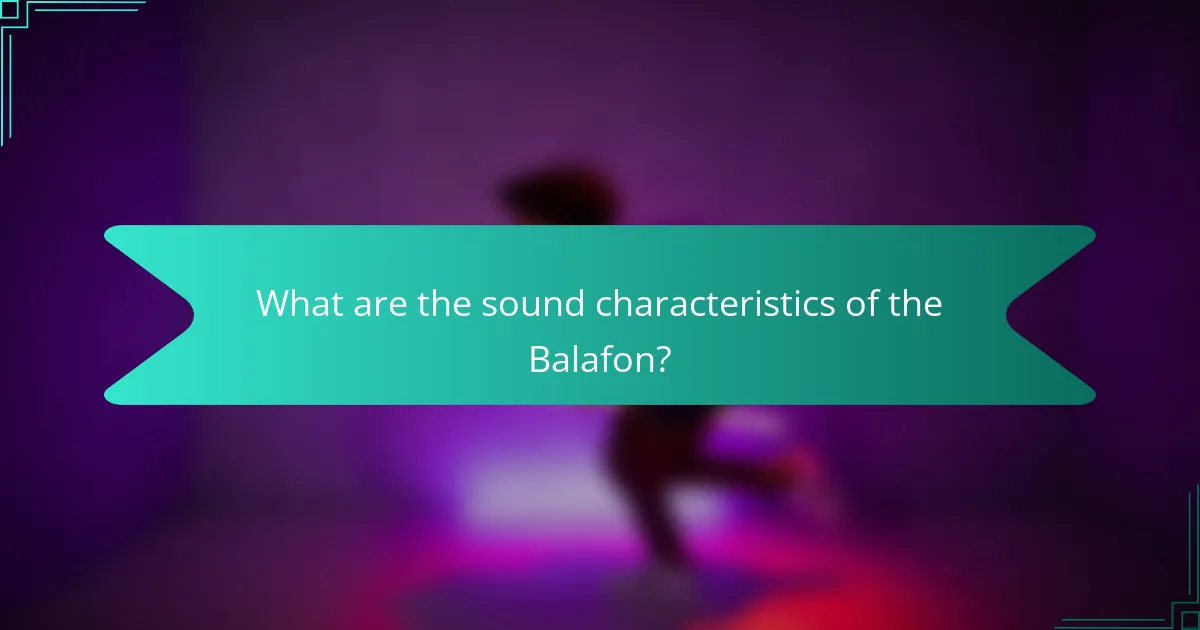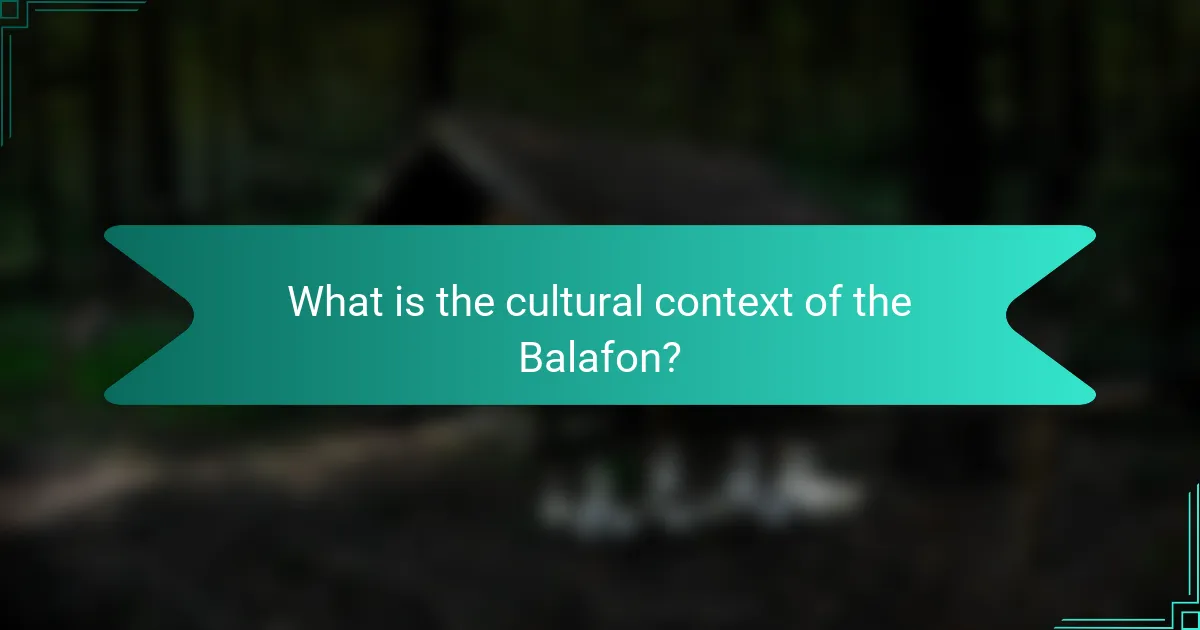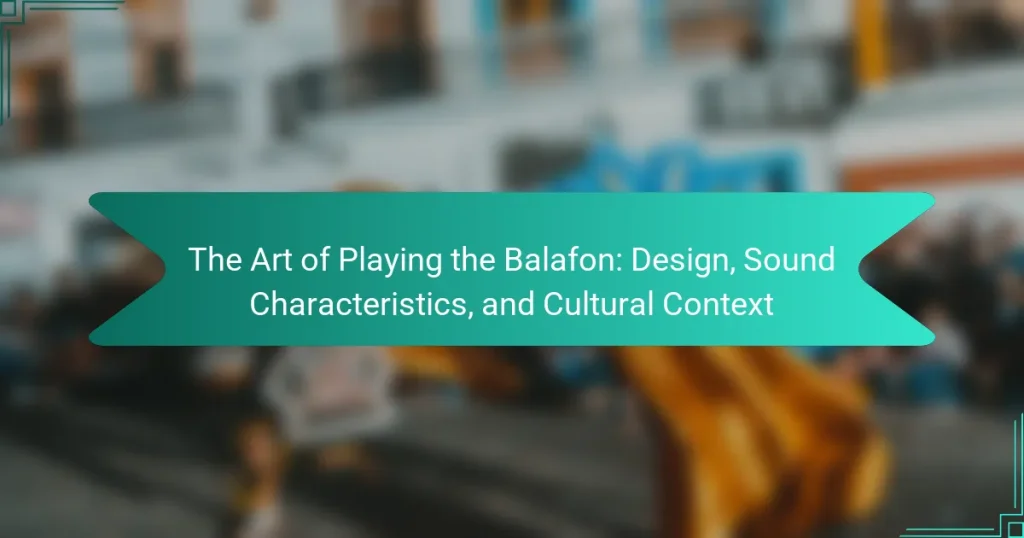The Balafon is a traditional West African wooden percussion instrument, similar to a xylophone, featuring wooden bars arranged over gourd or calabash resonators. This instrument produces a bright, resonant sound that is essential to various cultural ceremonies, storytelling, and social gatherings in regions such as Mali, Guinea, and Burkina Faso. The Balafon’s unique sound characteristics, including its melodic range and timbre, contribute significantly to West African musical traditions. Crafted with skill and cultural heritage, the Balafon serves as a vital means of communication and expression, connecting communities to their ancestral roots and enhancing celebrations.

What is the Balafon?
The Balafon is a traditional West African musical instrument. It is a type of wooden percussion instrument similar to a xylophone. The Balafon consists of wooden bars arranged over a resonator made from gourd or calabash. It is played by striking the bars with mallets. The instrument produces a rich, melodic sound that is integral to various cultural ceremonies. Historically, the Balafon has been used in storytelling, celebrations, and rituals. It is particularly prominent in countries such as Mali, Guinea, and Burkina Faso. The Balafon’s design and sound characteristics reflect the artistic heritage of the region.
How is the Balafon constructed?
The Balafon is constructed using wooden slats, which are typically made from hardwoods. These slats are carefully shaped and tuned to produce specific musical notes. The slats are arranged over a resonating chamber, often made from calabash gourds or hollowed wood, to enhance sound quality. The frame of the Balafon is usually built from sturdy wood to support the slats and maintain structural integrity.
Traditionally, the slats are secured to the frame using cords or ropes. This method allows for some flexibility in the tuning process. The instrument may also include resonators beneath the slats to amplify the sound further. The craftsmanship involved in constructing a Balafon often reflects cultural significance and regional styles. Each Balafon can vary in size, number of slats, and design, showcasing unique attributes specific to its maker and cultural context.
What materials are commonly used in Balafon design?
Balafons are commonly designed using wood, gourds, and metal. The wooden frame provides structural integrity and resonance. Specific woods like rosewood or padauk are often chosen for their acoustic properties. Gourds are used as resonators to amplify sound. Metal keys, traditionally made from iron or bronze, produce distinct tones. These materials contribute to the balafon’s unique sound and cultural significance.
What are the key components of a Balafon?
The key components of a Balafon include the wooden frame, resonators, and bars. The wooden frame provides structural support and shape. Resonators, often made from gourd or metal, enhance sound projection. Bars, typically made from hardwood, are tuned to specific pitches. Each bar is mounted on the frame and struck to produce sound. The tuning of the bars is crucial for musical accuracy. Balafons are traditionally used in various African cultures for storytelling and celebrations. Their design reflects both functionality and artistry.
What are the historical origins of the Balafon?
The Balafon originated in West Africa. It is a traditional wooden percussion instrument. Its roots can be traced back to ancient Mali and surrounding regions. The Balafon is believed to date back to the 12th century. Historical records indicate its use in the Mali Empire. The instrument was crafted from wood and gourds. It played a significant role in cultural ceremonies and storytelling. The Balafon symbolizes community and heritage in many African cultures.
How has the Balafon evolved over time?
The Balafon has evolved significantly from its origins in West Africa. Initially, it was constructed using wooden slats and calabash resonators. Over time, metal keys were introduced, enhancing its sound quality. The design has also diversified, with variations in size and shape across different cultures. Modern Balafons often incorporate synthetic materials for durability. This evolution reflects changes in musical styles and cultural exchanges. Historical records indicate the Balafon has been used in various ceremonial contexts, illustrating its cultural importance. Today, it is featured in both traditional and contemporary music globally.
What cultural significance does the Balafon hold in African traditions?
The Balafon holds significant cultural importance in African traditions. It is a traditional musical instrument associated with various ceremonies and celebrations. The Balafon is often used in storytelling, rituals, and communal gatherings. Its sound is believed to connect people to their ancestors and cultural heritage. In many West African societies, the Balafon symbolizes identity and community. It is also linked to social status and is played by skilled musicians. The instrument’s construction varies by region, reflecting local craftsmanship and cultural expressions. The Balafon is more than an instrument; it embodies the spirit and history of the communities that play it.

What are the sound characteristics of the Balafon?
The Balafon produces a rich, resonant sound characterized by its wooden bars and gourd resonators. Each bar is tuned to a specific pitch, creating a melodic range. The sound is bright and percussive, often described as warm and vibrant. The gourd resonators amplify the sound, adding depth and richness. The instrument can produce both staccato and legato notes, allowing for expressive playing. Additionally, the Balafon has a unique timbre that distinguishes it from other wooden percussion instruments. Its sound is integral to various West African musical traditions, enhancing cultural performances and ceremonies.
How does the Balafon produce sound?
The Balafon produces sound through the vibration of wooden bars. These bars are typically made from hardwood and are suspended over a resonating chamber. When struck with mallets, the bars vibrate, creating sound waves. The resonating chamber amplifies these sound waves, enhancing the volume and richness of the sound. The specific tuning of the bars affects the pitch produced. Each bar corresponds to a different note, allowing for melodic play. The craftsmanship in the Balafon’s design influences its tonal quality. This traditional instrument is integral to various cultural music practices in West Africa.
What role do the resonators play in sound production?
Resonators amplify and enrich the sound produced by the balafon. They work by vibrating in response to the sound waves generated by the instrument’s bars. This amplification enhances the volume and tonal quality of the sound. The material and shape of the resonators influence the timbre. For example, wooden resonators provide a warm, rich sound. Resonators also help sustain the notes longer. Their design is crucial for achieving the desired acoustic properties. Studies show that resonators significantly impact the overall sound experience in traditional African instruments.
How do the size and shape of the Balafon affect its sound?
The size and shape of the Balafon significantly influence its sound quality. Larger Balafons produce deeper, richer tones due to the increased surface area of the bars. The thickness of the bars also affects pitch; thicker bars yield lower notes. Conversely, smaller Balafons create higher, brighter sounds. The shape of the resonators beneath the bars amplifies sound; wider resonators enhance volume and resonance. The materials used in construction, such as wood and gourd, contribute to the timbre. Therefore, variations in size and shape directly correlate with the tonal range and overall sound characteristics of the Balafon.
What are the different playing techniques for the Balafon?
The Balafon can be played using various techniques, including striking, damping, and rolling. Striking involves using mallets to hit the wooden bars, producing sound. Damping is achieved by placing a hand on the bars to stop the sound immediately after striking. Rolling creates a rapid succession of notes by alternating strikes quickly on adjacent bars. Additionally, players may use different mallet types to achieve varied tonal qualities. These techniques are essential for expressing the instrument’s musical range and cultural significance.
How do various mallet types influence the sound?
Various mallet types influence the sound produced by the balafon significantly. The hardness of the mallet affects the clarity and projection of the sound. Harder mallets create a brighter, more piercing tone. Softer mallets produce a warmer, muted sound. The material of the mallet also plays a crucial role. Wooden mallets typically yield a softer sound compared to rubber or plastic mallets. The weight of the mallet impacts the volume and sustain of the notes. Heavier mallets can produce louder sounds with longer sustain. The design of the mallet, including its shape and size, further influences the timbre. Different mallet characteristics allow musicians to achieve diverse sound textures. This versatility is essential for expressing various musical styles on the balafon.
What techniques can enhance the performance quality of Balafon playing?
To enhance the performance quality of Balafon playing, musicians can focus on several techniques. Proper hand positioning is crucial for achieving clarity in sound. Utilizing different striking techniques, such as using mallets of varying hardness, can alter tone quality. Practicing rhythmic patterns consistently improves timing and precision. Incorporating dynamic control allows for expressive playing, making performances more engaging. Additionally, understanding the cultural context of the Balafon enriches the performance, as it informs stylistic choices. Regular practice and listening to skilled players can inspire new techniques and interpretations.

What is the cultural context of the Balafon?
The Balafon is a traditional West African musical instrument with deep cultural significance. It is commonly associated with various ethnic groups, including the Mandinka and Susu. The instrument plays a vital role in ceremonies, storytelling, and social gatherings. Its music often accompanies dances and rituals, serving as a means of communication and expression. The Balafon is typically crafted from wood and gourds, highlighting the artisans’ skills and cultural heritage. Its sound is considered sacred and is believed to connect the living with ancestral spirits. The instrument is often featured in celebrations, emphasizing community and cultural identity.
How is the Balafon integrated into traditional ceremonies?
The Balafon is integral to traditional ceremonies in many West African cultures. It serves as a key musical instrument during celebrations, rituals, and communal gatherings. The instrument is often played to accompany storytelling, dance, and spiritual ceremonies. Its unique sound enhances the cultural significance of these events. In many communities, the Balafon symbolizes unity and heritage. The rhythms and melodies played on the Balafon can evoke emotions and connect participants to their ancestry. Additionally, skilled players are often regarded as cultural custodians. This integration reflects the Balafon’s role in preserving and expressing cultural identity.
What role does the Balafon play in storytelling and oral traditions?
The Balafon serves as a vital instrument in storytelling and oral traditions. It enhances narratives through its melodic sounds, creating emotional connections. Traditionally, griots or storytellers utilize the Balafon to accompany tales, adding rhythm and depth. Its unique tones help convey the mood and themes of stories. The instrument also aids in preserving cultural heritage, passing down history through generations. In many West African cultures, the Balafon is integral to community gatherings, reinforcing social bonds. Its role in oral traditions exemplifies the fusion of music and storytelling.
How does the Balafon contribute to community identity and cohesion?
The Balafon contributes to community identity and cohesion through its role in cultural rituals and celebrations. It serves as a musical instrument that embodies the traditions and values of a community. The Balafon is often played during important events, reinforcing social bonds among participants. Its distinct sound creates a shared experience that fosters unity. In many West African cultures, the Balafon is used to tell stories and convey messages, linking generations together. This connection to heritage enhances a sense of belonging among community members. Additionally, the collaborative nature of playing the Balafon encourages teamwork and cooperation, further solidifying community ties.
What contemporary uses does the Balafon have?
The Balafon is used in various contemporary musical contexts. It serves as a key instrument in traditional African music ensembles. Musicians incorporate it into modern genres like world music and fusion. The Balafon is also featured in theatrical performances and dance. Workshops and educational programs utilize the Balafon for teaching music. Additionally, it appears in recordings and live performances by various artists. Its unique sound adds cultural richness to contemporary compositions. The Balafon continues to bridge traditional and modern musical expressions.
How are modern musicians incorporating the Balafon into various music genres?
Modern musicians are incorporating the Balafon into various music genres by blending its unique sound with contemporary styles. Artists in genres like jazz, hip-hop, and world music utilize the Balafon to add rhythmic complexity. The instrument’s wooden bars produce a warm, resonant tone that enhances melodic lines. Collaborations between traditional Balafon players and modern musicians create innovative fusion tracks. For instance, tracks by artists like Kora Jazz Trio feature the Balafon prominently. This integration showcases the Balafon’s versatility across different musical landscapes. Additionally, electronic music producers sample Balafon sounds to create new textures. This approach highlights the instrument’s cultural significance while appealing to modern audiences.
What educational programs exist for learning the Balafon?
Educational programs for learning the Balafon include workshops, online courses, and music schools. These programs often focus on traditional techniques and cultural contexts. For example, many African music schools offer specialized classes on the Balafon. Additionally, online platforms provide tutorials and lessons from experienced musicians. Community centers may also host group lessons. Some universities include Balafon studies in their world music programs. These educational offerings help preserve and promote the cultural significance of the Balafon.
What tips can improve your Balafon playing skills?
Practice regularly to improve your Balafon playing skills. Consistent practice helps develop muscle memory and timing. Focus on mastering basic techniques before advancing to complex rhythms. Use a metronome to enhance your timing and rhythm accuracy. Experiment with different mallet grips to find what feels comfortable. Listen to recordings of skilled Balafon players for inspiration and technique insights. Record your practice sessions to identify areas for improvement. Engage in group play to enhance your listening skills and adaptability.
How can regular practice enhance your performance?
Regular practice enhances performance by improving skill proficiency and muscle memory. Consistent engagement with the balafon allows players to develop greater familiarity with its keys and sound production. This leads to increased accuracy in striking the bars. Enhanced timing and rhythm also result from regular practice. Musicians can better interpret musical pieces and express emotions through their playing. Research shows that 10,000 hours of deliberate practice can lead to mastery in a skill. The study by Ericsson, Krampe, and Tesch-Römer highlights the importance of focused practice in achieving high levels of performance. Therefore, regular practice is essential for mastering the balafon and achieving artistic expression.
What resources are available for aspiring Balafon players?
Aspiring Balafon players can access various resources to enhance their skills. Instructional books about Balafon techniques are available. Online video tutorials provide visual guidance for beginners. Local music schools may offer classes focused on traditional African instruments. Community workshops often feature experienced Balafon players as instructors. Additionally, online forums and social media groups connect learners with experienced musicians. Cultural organizations may host events showcasing Balafon performances, providing inspiration and networking opportunities. These resources collectively support the learning journey of aspiring Balafon players.
The Balafon is a traditional West African wooden percussion instrument similar to a xylophone, characterized by its wooden bars arranged over gourd or calabash resonators. This article explores the Balafon’s construction, sound characteristics, and cultural significance, detailing its historical origins, evolution, and role in storytelling and community identity. Additionally, it examines contemporary uses of the Balafon in various music genres and educational resources for aspiring players, providing a comprehensive understanding of this integral instrument in West African culture.




